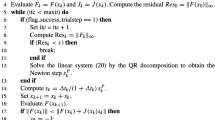Abstract
A matrix-free monolithic homotopy continuation algorithm is developed which allows for approximate numerical solutions to nonlinear systems of equations without the need to solve a linear system, thereby avoiding the formation of any Jacobian or preconditioner matrices. The algorithm can converge from an arbitrary starting guess, under suitable conditions, and can give a sufficiently accurate approximation to the converged solution such that a rapid locally convergent method such as Newton’s method will converge successfully. Several forms of the algorithm are presented, as are augmentations to the algorithms which can lead to improved efficiency or stability. The method is validated and the stability and efficiency are investigated numerically based on a computational aerodynamics flow solver.
Similar content being viewed by others
References
Allgower, E.L., Georg, K.: Introduction to numerical continuation methods. Soc. Ind. Appl. Math. (1990)
Brown, D.A., Zingg, D.W.: Advances in homotopy-based globalization strategies in computational fluid dynamics. AIAA-2013-2944 (2013)
Brown, D.A., Zingg, D.W.: A monolithic homotopy continuation algorithm with application to computational fluid dynamics. J. Comp. Phys. 321, 55–75 (2016)
Carpenter, M.H., Gottlieb, D., Abarbanel, S.: Time-stable boundary conditions for finite-difference schemes solving hyperbolic systems: methodology and application to high-order compact schemes. J. Comput. Phys. 111(2), 220–236 (1994)
Del Rey Fernández, D.C., Hicken, J.E., Zingg, D.W.: Review of summation-by-parts operators with simultaneous approximation terms for the numerical solution of partial differential equations. Comput. Fluids 95, 171–196 (2014)
DLR Germany: Taubench version 1.1, IPACS. http://www.ipacs-benchmark.org. Accessed: 2014-09-20 (2014)
Funaro, D., Gottlieb, D.: A new method of imposing boundary conditions in pseudospectral approximations of hyperbolic equations. Math. Comput. 51, 599–613 (1988)
Getz, N.H.: Dynamic inversion of nonlinear maps with applications to nonlinear control and robotics. Ph.D. thesis, University of California at Berkeley, Berkeley (1995)
Getz, N.H., Marsden, J.E.: A dynamic inverse for nonlinear maps Proceedings of the 34Th IEEE conference on decision and control, vol. 4, pp 4218–4223 (1995)
Getz, N.H., Marsden, J.E.: Tracking implicit trajectories IFAC symposium on nonlinear control systems design. Tahoe City (1995)
Hartman, P.: Ordinary Differential Equations, 2nd edn. Birkhauser, Berlin (1982)
Hicken, J.E., Buckley, H., Osusky, M., Zingg, D.W.: Dissipation-based continuation: a globalization for inexact-Newton solvers. AIAA 2011-3237 (2011)
Hicken, J.E., Zingg, D.W.: A parallel Newton-Krylov solver for the Euler equations discretized using simultaneous approximation terms. AIAA J. 46(11), 2773–2786 (2008)
Hicken, J.E., Zingg, D.W.: Globalization strategies for inexact-Newton solvers. AIAA-2009-4139 (2009)
Jackiewicz, Z.: General linear methods for ordinary differential equations. Wiley, Hoboken (2009)
Jameson, A., Yoon, S.: Multigrid solution of the Euler equations using implicit schemes. AIAA-85-0293 (1985)
Kreiss, H., Scherer, G.: Finite element and finite difference methods for hyperbolic partial differential equations. In: de Boor, C. (ed.) Mathematical aspects of finite elements in partial differential equations: proceedings of a symposium conducted by the mathematics research center, the University of Wisconsin, pp. 195–212. Mathematics Research Center, the University of Wisconsin, Academic Press (1974)
Lomax, H., Pulliam, T.H., Zingg, D.W.: Fundamentals of computational fluid dynamics. Springer, Berlin (2001)
Nadaraya, E.A.: On estimating regression. Theor. Probab. Appl. 9(1), 141–142 (1964)
Osusky, M., Zingg, D.W.: A parallel Newton-Krylov-Schur flow solver for the Navier-Stokes equations discretized using summation-by-parts operators. AIAA J. 51(12), 2833–2851 (2013)
Pulliam, T.H., Zingg, D.W.: Fundamental algorithms in computational fluid dynamics. Springer, Berlin (2014)
Saad, Y.: Iterative methods for sparse linear systems, 2nd edn. SIAM, Philadelphia (2003)
Saad, Y., Schultz, M.: GMRES: a generalized minimal residual algorithm for solving nonsymmetric linear systems. SIAM J. Sci. Stat. Comp. 7, 856–869 (1986)
Watson, G.S.: Smooth regression analysis. Sankhya Ser. A 26(4), 359–372 (1964)
Yu, M., Wang, Z.J.: Homotopy continuation for correction procedure via reconstruction—discrete Galerkin (CPR-DG) methods. AIAA 2015-0570 (2015)
Acknowledgements
The authors gratefully acknowledge financial assistance from the Natural Science and Engineering Research Council (NSERC), the Canada Research Chairs program, and the University of Toronto. Computations were performed on the GPC supercomputer at the SciNet HPC Consortium. SciNet is funded by: the Canada Foundation for Innovation under the auspices of Compute Canada; the Government of Ontario; Ontario Research Fund - Research Excellence; and the University of Toronto.
Author information
Authors and Affiliations
Corresponding author
Rights and permissions
About this article
Cite this article
Brown, D.A., Zingg, D.W. Matrix-free monolithic homotopy continuation with application to computational aerodynamics. Numer Algor 78, 1303–1320 (2018). https://doi.org/10.1007/s11075-017-0424-8
Received:
Accepted:
Published:
Issue Date:
DOI: https://doi.org/10.1007/s11075-017-0424-8




